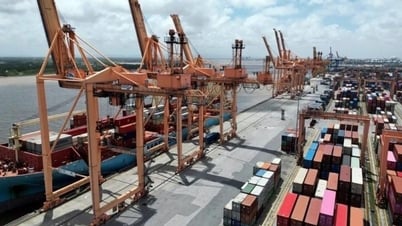Vietnam’s logistics and supply management sector is recovering strongly with great potential. Despite many challenges, Vietnam’s logistics and supply are forecasted to continue to maintain growth momentum.
Vietnam's logistics and supply industry is forecast to continue its growth momentum.
Vietnam’s logistics and supply management sector is recovering strongly with great potential. Despite many challenges, Vietnam’s logistics and supply are forecasted to continue to maintain growth momentum.
The current growth rate of Vietnam’s logistics sector shows an improvement in the volume of goods moving in a volatile environment. However, this increase is not enough to improve the financial results of businesses, especially those affected by the impact of the previous economic recession.
Logistics companies continue to operate despite facing severe financial pressures. Many are reporting low or even negative profit margins. This financial vulnerability has left many on the brink of bankruptcy, underscoring the importance of strategy and strong financial backing.
The international logistics market is experiencing many fluctuations, the cost of transporting import and export goods has increased dramatically for almost a year, then started to decrease recently. This erratic pricing makes the market even more unpredictable, making the financial planning of logistics enterprises more complicated, especially global freight enterprises.
Vietnam’s warehousing sector also faces many challenges. In 2022 and 2023, Vietnam witnessed a surge in new warehouse investment projects due to optimistic forecasts for the industry’s growth. However, these forecasts did not materialize, leading to a warehouse oversupply. This surplus, combined with lower-than-expected demand, resulted in a lot of unused warehouse space, leading to a decline in rental prices. This trend will continue until demand catches up with supply.
In addition, the impact of Typhoon Yagi also severely disrupted logistics and supply chain operations, especially in the northern provinces. The consequences of such natural disasters once again underscore the importance of disaster preparedness and resilience in operational planning.
Economic pressures on logistics companies and shippers continue to mount amid a challenging business environment and volatile international shipping costs, clouding earnings prospects and forcing companies to step up financial scrutiny.
Going forward, the market is likely to consolidate as smaller, financially weaker companies struggle under economic pressure, paving the way for larger companies to expand their market share. This consolidation trend may help the market maintain stability, but low prices will remain in the short to medium term due to the existing oversupply.
Innovation is one of the key drivers of growth under normal circumstances. However, investment in innovation will be limited as companies prioritize immediate business and challenges over long-term strategic initiatives.
Recurring disruptions, including natural disasters like Typhoon Yagi, can be a catalyst for a much-needed shift toward greater resilience. This requires increased infrastructure investment, diversification of facilities, and refinement of risk management and continuity planning to better withstand crises.
Despite the challenges facing the logistics and supply chain sector in Vietnam in 2024, there is potential for transformational growth and development. Difficulties can push the logistics and supply chain sector to become stronger and more efficient in the long term, as companies are forced to adapt and innovate.
However, stakeholders should temper expectations and recognise that the road to recovery will require significant restructuring, and that some businesses may fail before achieving stability and growth.
Source: https://baodautu.vn/du-bao-nganh-logistics-va-cung-ung-cua-viet-nam-se-tiep-tuc-da-tang-truong-d228263.html



![[Photo] Top players gather at the 2025 Nhan Dan Newspaper National Table Tennis Championship](https://vphoto.vietnam.vn/thumb/1200x675/vietnam/resource/IMAGE/2025/5/23/9ad5f6f4faf146b08335e5c446edb107)

























































































Comment (0)